GO In The West
BADUK In Korea
IGO In Japan
WEIQI In China
© Craig R. Hutchinson, 22 April 2006
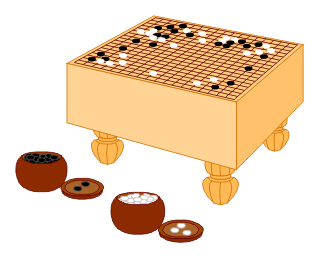
A Contest of
Life, Liberty and the Pursuit of Happiness
Two players,
one using black stones and the other white stones,
alternately place a stone on an intersection point of a grid.
Black plays first.
To remain on the grid (Life), a stone or stone string
must have a vacant adjacent intersection point
on a line extending from the stone or stone string (Liberty).
The player with the greater total of stones and liberties
on the grid wins the contest (Happiness).
How did the contest originate?
More than 20,000 years ago,
before the planet Venus settled
into its current orbit in our solar system,
there lived two men in Asia named Hei and Bai.
During the day they watched a large bright object
named the Sun as it moved across the sky.
At night they watched a large bright object
named the Moon as it moved across the sky.
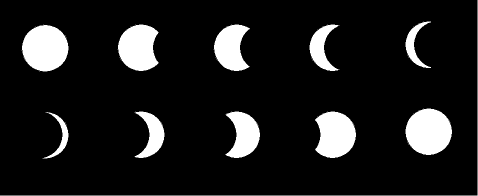
They were fascinated by the Moon changing its shape each night.
Someone asked
how many nights it would take
to see all the shapes of the Moon turning black and white.
To find the answer,
Hei thought of using the fingers on his hands to mark the nights.
Bai thought it would be more than a handful of fingers
and suggested putting stones on the ground in rows
equal to the number of fingers on the hand
to determine how many nights.

After the 7th night their stones on the ground
looked like this as they marked how many nights
it would take for the Moon to become all black again.
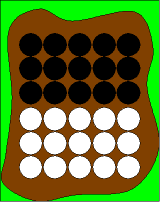
They used black stones for the Moon turning black
and white stones for the Moon turning white.
They discovered after watching the Moon on many nights
that it took this many nights to see all the shapes.
They named Moon’s travels a month
and divided Moon’s month into six five-day weeks.


They then etched on the ground 5x6 and 3x10 line grids
with 30 intersection points, named Moon grids,
to keep track of the Moon’s shape.
Since rained destroyed the grids and they traveled around,
they decided to make their Moon grids more portable
by putting them on blocks of wood.
Another person noticed that
the Sun did not rise or set at the same place
on the horizon each day and night.
They observed that the Sun went so far in one direction
before going the other way,
and that it took many days to return.
Someone asked
how many days, weeks, or months must pass
before it would return.
To determine the answer to this question,
Hei and Bai placed stones on the Moon grids
to mark the days.
Now this was not as easy as marking Moon nights,
as it required many more days of placing stones on Moon grids.
Each day Hei watched the Sun set on the horizon
and placed a stone on the grid.
Bai checked Hei’s mark
by verifying the place on the horizon where the Sun went down,
as well as Hei’s laborious work
of placing a stone on the Moon grid.
Then they partied well into the night celebrating their work
and finally got some sleep in preparation for the next day.
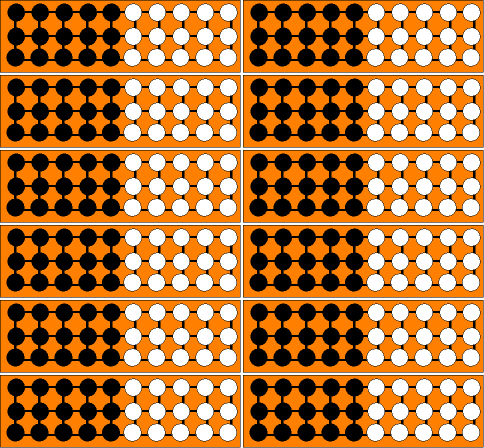
After many days the Sun finally completed its journey.
This is how many stones they used.
They were surprised that it took
exactly 12 Moon months,
with 72 five-day weeks and 360 days,
plus one day for a total of 361 days.
They named the Sun’s travels a year
and discovered they could rearrange the 12 moon grids
to make a 19x19 line grid with 361 points
with the last day the center point.
They named it a Sun grid
and made one on a block of wood.
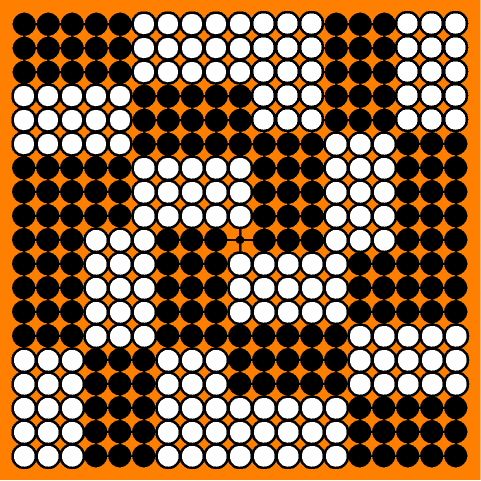
To help keep account of the 361 days,
they divided the Sun's year into:
a) four seasons
represented by the grid's four quarters;
b) twelve Moon months
represented by the grid's twelve 3x10 sections;
c) 72 five-day weeks
represented by the 72 grid edge points, and
d) the last day
represented by the center point.
To double check their count,
they tagged the weeks on one grid and the months on another.
They were proud of the grids they made
for marking the sunsets and
the movements of the Sun on the horizon.
With much time on their hands each day
while waiting for the Sun to set,
they began polishing and using agate and quartz stones
in place of the pebbles they found on the ground.
Hei and Bai now had a way
of representing the concept of how many.
When was how many first asked?
What was the first how many?
How was it answered?
What did they count how many of 20,000 years ago?
People? Animals? Days?
Now as any good mathematician knows,
after you create a new calculator you have more time to play.
To pass the time while waiting for the Sun to set,
they started having contests with each other.
A contest they created on the Sun grid’s 17x17 line points
inside the 72 grid edge points
was to see who could get five stones in a row first.
They named it Five-In-A-Row.
A contest they created on a 5x6 Moon grid
was to see who could be first to surround and remove
at least one of their foe’s stones
by alternately placing
their agate and quartz stones on the grid.
They named it First Capture.
After a few Moons,
First Capture became too easy,
so they modified the contest to see
who could capture the most stones
by removing captured stones.
They named it Most Capture.
Another contest they created was to see
who could connect opposite edges of the grid first.
They named it Connect.
Over the next few years,
Five-In-A-Row, Most Capture, and Connect became too easy.
They then began another contest
to see who could place and maintain the most stones
on a Sun grid with captured stones removed.
They named it Yi.
During the next 18,000 years,
Venus entered our solar system and traveled around the Sun
in an irregular path before it settled into its current orbit.
On many occasions,
approximately every 700 years,
it came close to the Earth
and created tremendous damages and changes.
For example,
it helped produce
the ice ages,
the Alps,
floods,
and the sinking of Atlantis.
In addition,
it affected the travels of the Moon and the Earth.
The Moon now takes approximately
28 days to go through its changes
and the Sun takes approximately
365 days to travel across the horizon.
Fortunately the human species was able to survive these events.
Yi was later modified in China,
with the winner now the player with the most
stones and vacant adjacent intersection points on the grid.
They named it WeiQi.
As the contest spread across Asia more than 2,000 years ago,
it was named Baduk in Korea and Igo in Japan.
More than 100 years ago
it became known in Europe and the USA and was named Go.
Today millions of people play WeiQi
and much prize money and many awards are available
for the best players.
Now you too can enjoy one of the world’s first calculators and some of the first contests people played on the calculator.
To find more information about events
which occurred on our planet,
visit your local library and
check out three books by Immanuel Velikovsky
published in the 1950s:
Worlds in Collision,
Ages in Chaos,
Earth in Upheaval.
HOW TO PLAY FIRST CAPTURE
Starting with black, alternately place black and white stones
on the intersection points of an mxn line grid.
Same color stones on adjacent points of a line are a string.
A vacant adjacent point on a line from a stone or string is a liberty.
A string, or a stone not part of a string, with no liberty is captured.
A play consists of the following three steps:
1) Place a stone on a vacant point;
2) Remove other color captured stones or strings;
3) Remove same color captured stones or strings.
A player must play (cannot pass).
The first captured colored stone or string wins for the other color.
HOW TO PLAY MOST CAPTURE
A play cannot repeat a grid position.
A player may pass (not make a play).
A game ends after consecutive black and white passes.
The color with the most captured foe's stones wins.
HOW TO PLAY YI
The color with the most stones on the grid wins.
HOW TO PLAY WEIQI
The score is the sum of the color’s stones and liberties on the grid.
A shared liberty counts ½.
White’s score receives 7.5 offset points for playing second.
The color with the higher score wins.
HOW TO PLAY GO, BADUK, OR IGO
Stones and/or strings that cannot maintain their liberties
with continued play after the game ends are removed.
The score is the sum of the color’s surrounded vacant points
(A shared liberty counts ½.)
minus the sum of the color’s removed stones and passes.
White’s score receives 7.5 offset points for playing second.
The color with the higher score wins.
HOW TO PLAY WITH A HANDICAP OF N
Black makes N plays before white plays with a .5 offset point.
The handicap changes by one after three consecutive wins.
MORE INFORMATION
For players, clubs, and playing on the Internet contact:
The American Go Association
PO Box 397, Old Chelsea Station
New York City, NY 10113-0397
E-mail: membership@usgo.org
Net: www.usgo.org
or contact Hutch
Phone: 703-698-9811
E-mail: crhutch@erols.com
Net: http://users.erols.com/crhutch/go.html
To obtain books and equipment, contact:
Ishi Press
Phone: 800-859-2086
E-mail: IshiPress@aol.com
Net: http://www.ishigames.com
Kiseido
Phone: 800-988-6463
E-mail: kiseido@yk.rim
Net: www.kiseido.com
Samarkand
Phone: 800-600-4373
E-mail: info@samarkand.net
Net: www.samarkand.net
Slate & Shell
Phone: 800-653-7640
E-mail: bcobb@slateandshell.com
Net: www.slateandshell.com
Yutopian Enterprises
Phone: 800-988-6463
E-mail: sales@yutopian.com
Net: www.yutopian.com